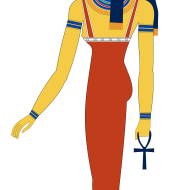Nut : The Goddess of the Sky
Listen
Nut
Introduction
In Egyptian mythology, the goddess of the sky is called Nut, and she’s often depicted as an arched woman over the Earth’s god, Geb. Most cultures believe that rain is the seed that nurtures Mother Earth. But in Egypt, it plays no role in the fertility of the land.
The religion of Egypt is unique when it comes to the genders of its deities. In one of its festivals, the goddess of the sky, known as Nut, swallowed the sun and gave birth to it in the evening. She was also depicted as a cow to carry the sun god back to the sky. During the five days preceding the New Year, which are usually referred to as the “birth” of the gods, she gave birth to various deities, including the ones mentioned above.
Physical Traits
One of the most notable features of the image of Nut is that she’s arched over the Earth’s god, Geb. Her body is covered with stars, and she has a protective dome over him and all of his creatures. She was sometimes depicted as a cow or a sow, which signifies her role as the mother of the gods.
The sacred symbol of Nut is the ladder that was used by her brother, Osiris, to enter her realm. This symbol, which is called Maqet, was placed in a tomb to protect the deceased. Egyptian artists would also portray Nut as a woman who is holding a pot of water, which signifies her role as the giver of rain. She was also painted on coffins as a symbol of protection and escort.
Even though she was highly regarded by ancient Egyptians, the worshipping of Nut was never as common as that of other deities. She is only known in modern times among those who study the culture of ancient Egypt.
Family
Nut was the daughter of Shu, the god of air, and Tefnut, the goddess of moisture. She was also the granddaughter of Ra, the sun god and the supreme creator. She was married to Geb, the god of the earth, and she was the mother of Osiris, Isis, Set, Nephthys, and Horus the Elder. These five gods were known as the “children of Nut”, and they played major roles in Egyptian mythology.
Egyptians believed that Geb and Nut were passionate lovers. At one point, they were so close that no one could come between them. Due to her jealousy, Shu separated the two. The mythological separation of the sky and the earth occurred too late, and Nut became pregnant. Because of this, she gave birth to all the planets and stars. Her offspring would always stay close by as she was the goddess of the sky.
Despite being cursed by her father, who left her barren, Nut still managed to get her hands on Thoth. She then gave birth to five children. Her kids, who were named Osiris, Set, Isis, and Nephthys, were regarded as some of the most important deities in Egypt.
Other names
Due to the absence of vowels in ancient Egyptian writing, the pronunciation of some of the names is uncertain. However, her name is usually transcribed as Nwt, which means “Sky,” and and times appear in older sources such as Nusuch, Nut, Nent, and Nuit.
Powers and Abilities
In Egyptian mythology, Nut was known to perform various tasks. One of these is to swallow the sun god Ra and grant him a child every morning. This explains how the sun appears at night and disappears at the start of the day. She was also able to create the phases of the moon by consuming the moon and other heavenly bodies.
She is regarded as a highly influential deity in Egyptian religion. She’s the mother of the gods, protector of the universe, and the source of life. She was also a principle that helped shape the values and culture of ancient Egypt.
Modern Day Influence
One of the most famous books that dates back to ancient Egypt is the Book of Nut. It’s a collection of astronomical texts that date back to at least 2,000 BC. It features a lot of information about the stars and the planets, as well as timekeeping and the various deities of Earth and the sky. As the goddess of the sky, Nut plays a major role in the book. In the movie Gods of Egypt (2016), Nut is portrayed by Emma Booth. She is the wife of Ra, the sun god, and the mother of Osiris, Isis, Set, and Nephthys. She helps Horus, the son of Osiris and Isis, to fight against Set, who has usurped the throne of Egypt.
Related Images
Frequently Asked Questions
What is lorem Ipsum?
I am text block. Click edit button to change this text. Lorem ipsum dolor sit amet, consectetur adipiscing elit. Ut elit tellus, luctus nec ullamcorper mattis, pulvinar dapibus leo.
What is lorem Ipsum?
I am text block. Click edit button to change this text. Lorem ipsum dolor sit amet, consectetur adipiscing elit. Ut elit tellus, luctus nec ullamcorper mattis, pulvinar dapibus leo.
What is lorem Ipsum?
I am text block. Click edit button to change this text. Lorem ipsum dolor sit amet, consectetur adipiscing elit. Ut elit tellus, luctus nec ullamcorper mattis, pulvinar dapibus leo.
What is lorem Ipsum?
I am text block. Click edit button to change this text. Lorem ipsum dolor sit amet, consectetur adipiscing elit. Ut elit tellus, luctus nec ullamcorper mattis, pulvinar dapibus leo.
What is lorem Ipsum?
I am text block. Click edit button to change this text. Lorem ipsum dolor sit amet, consectetur adipiscing elit. Ut elit tellus, luctus nec ullamcorper mattis, pulvinar dapibus leo.











